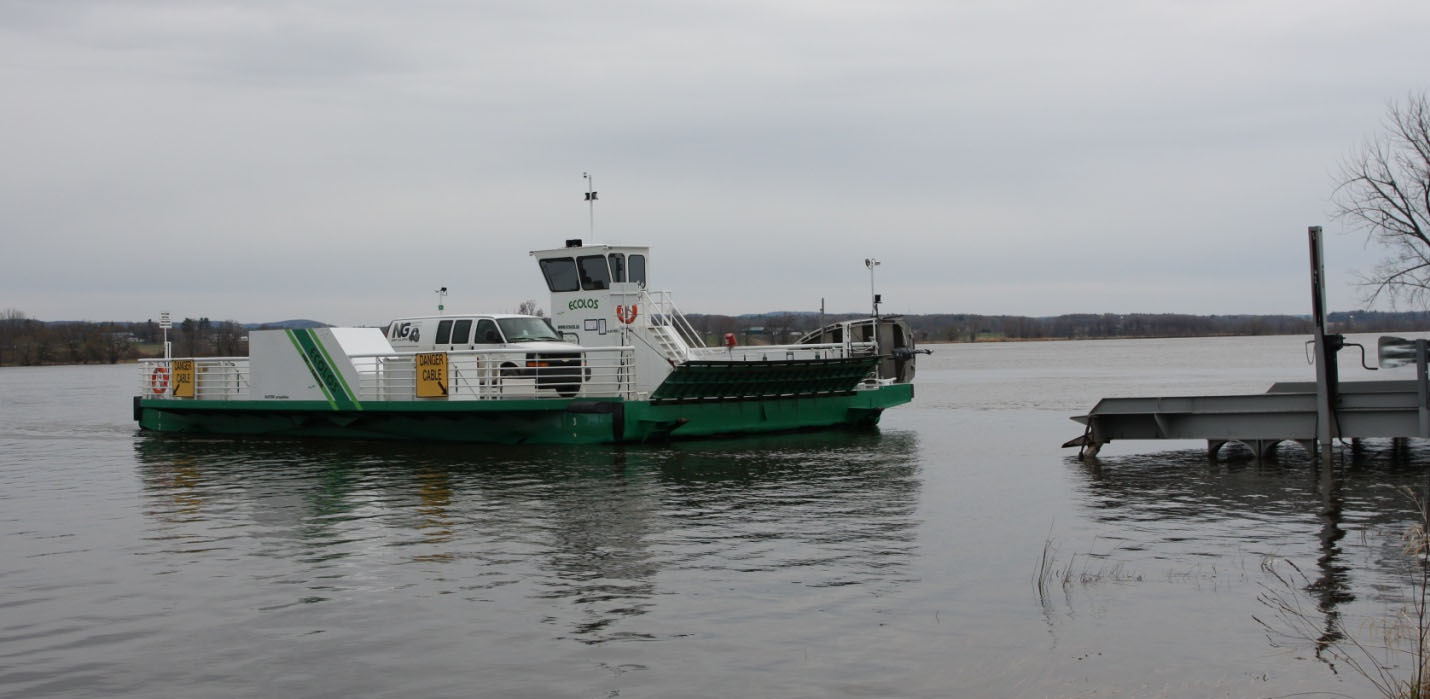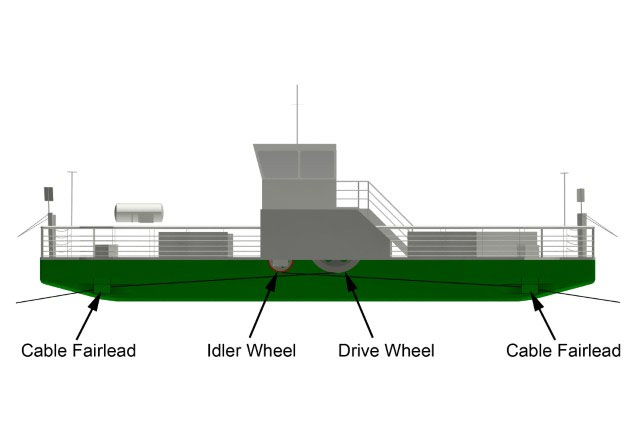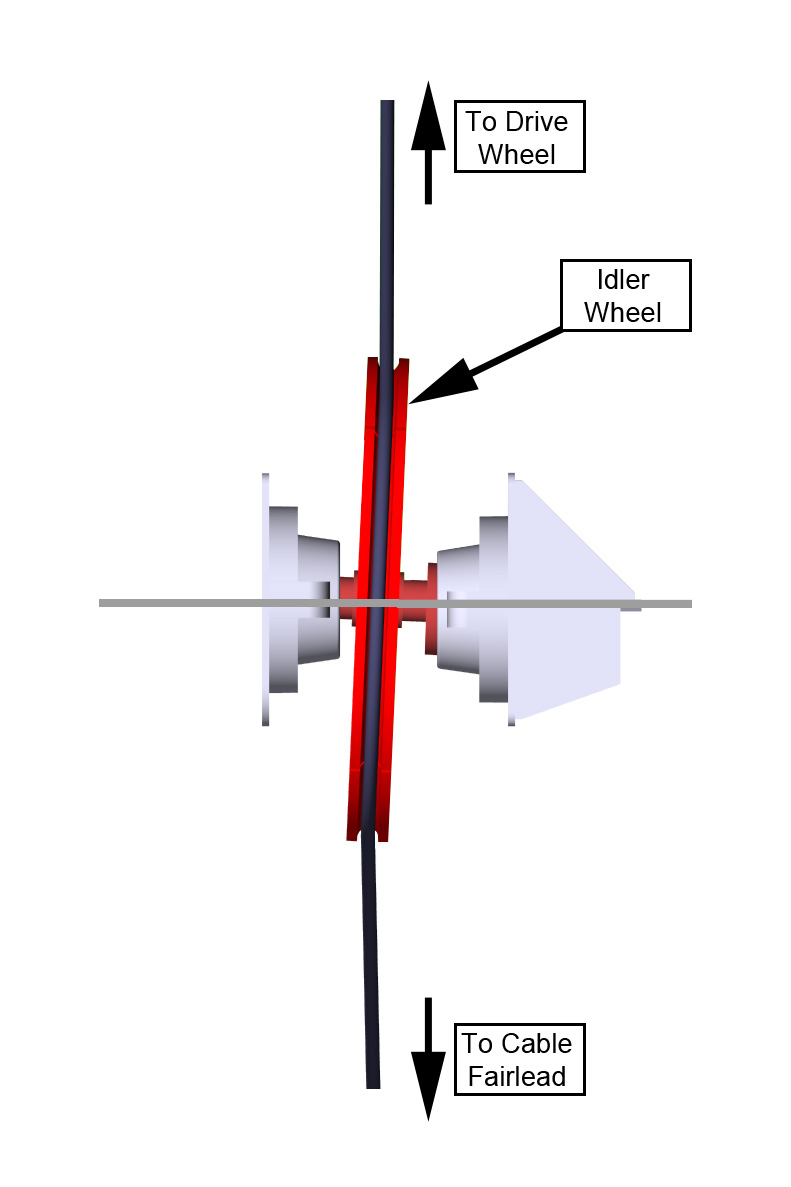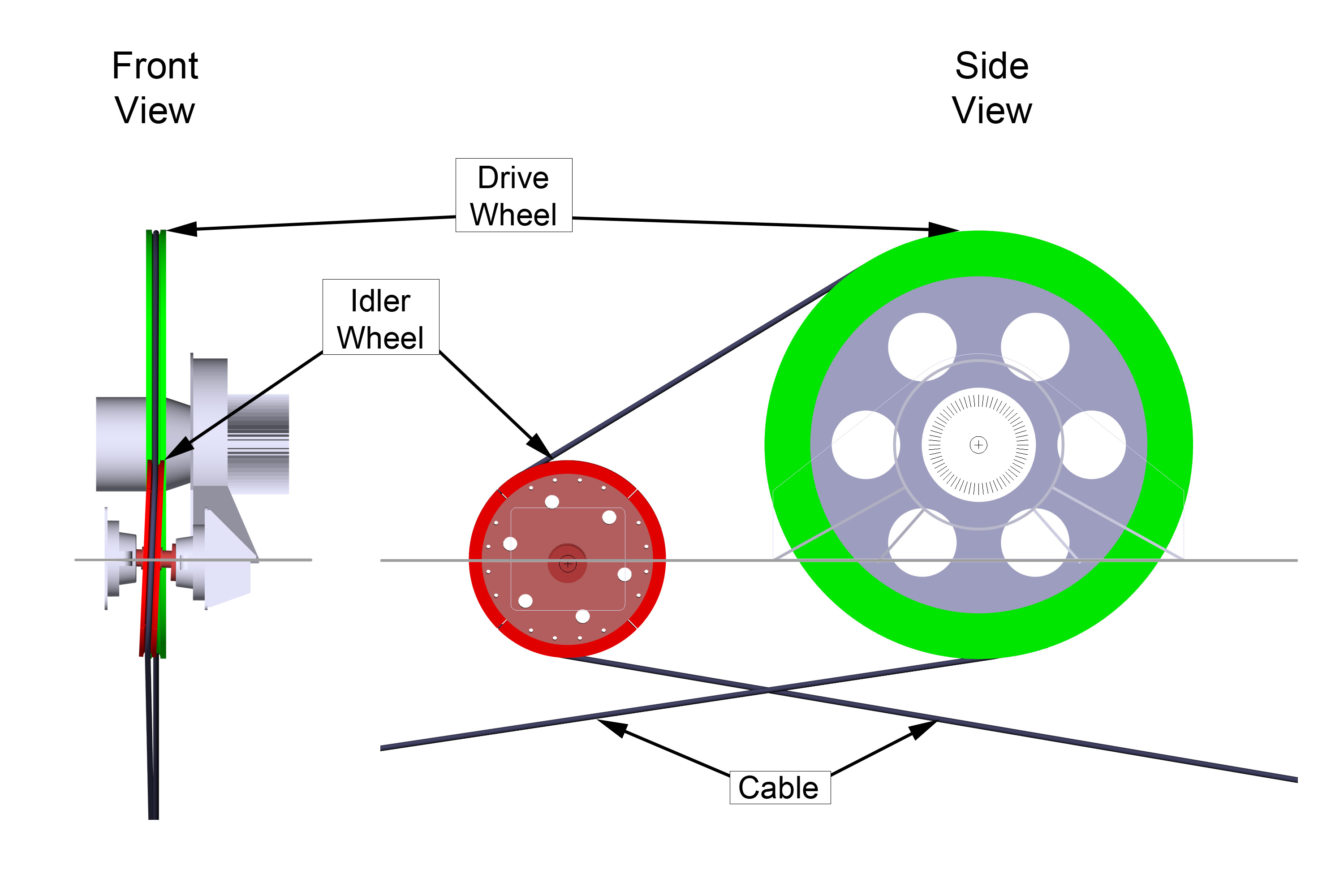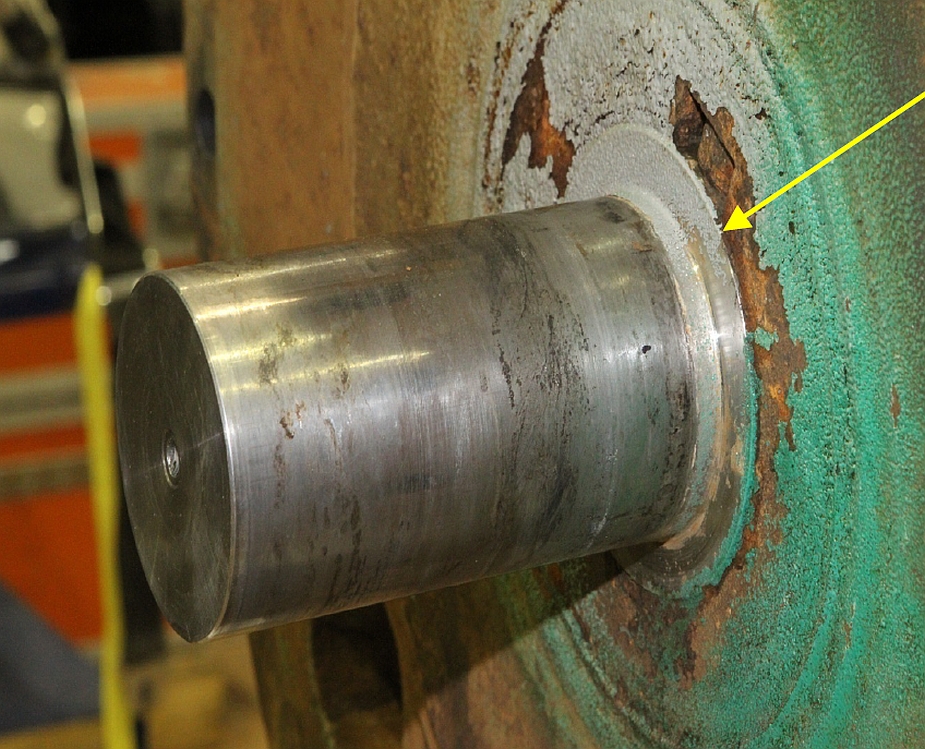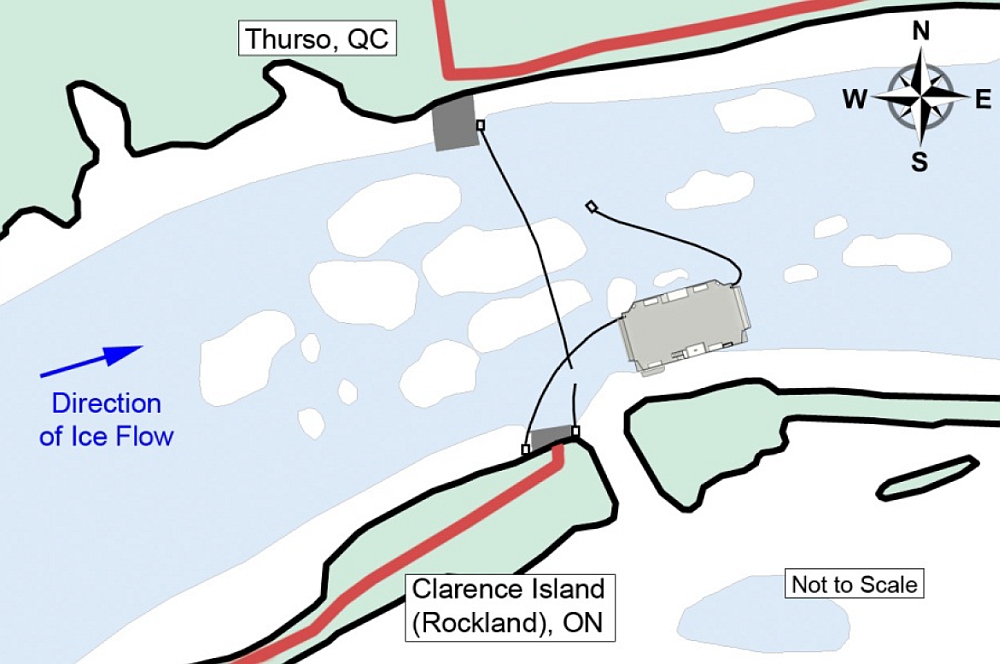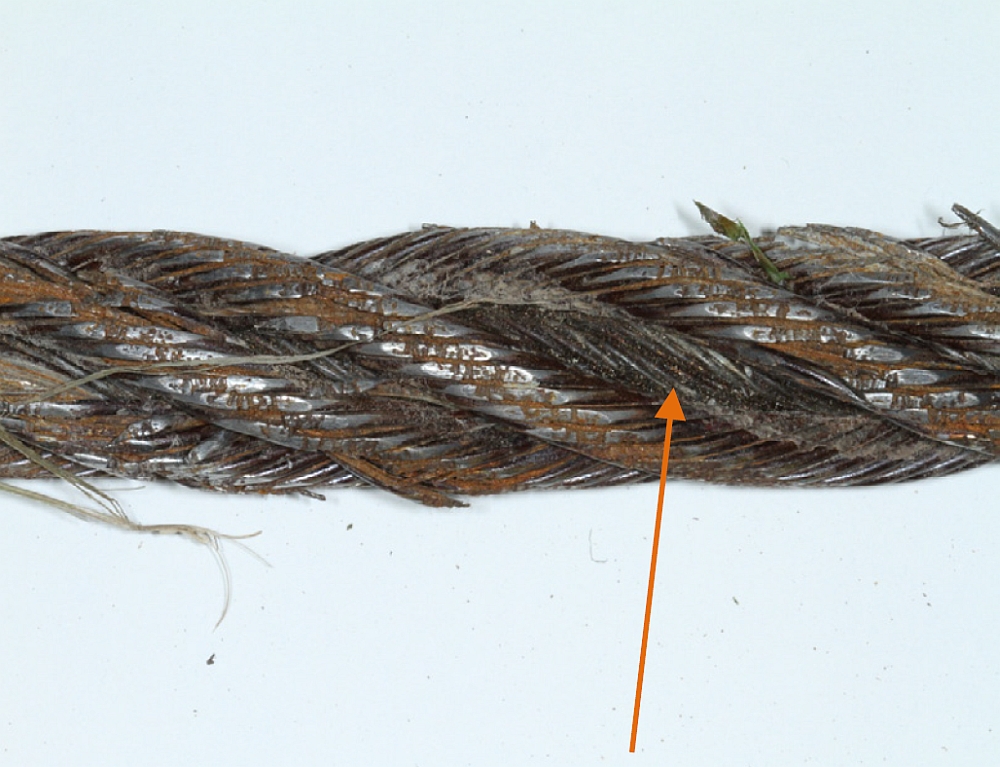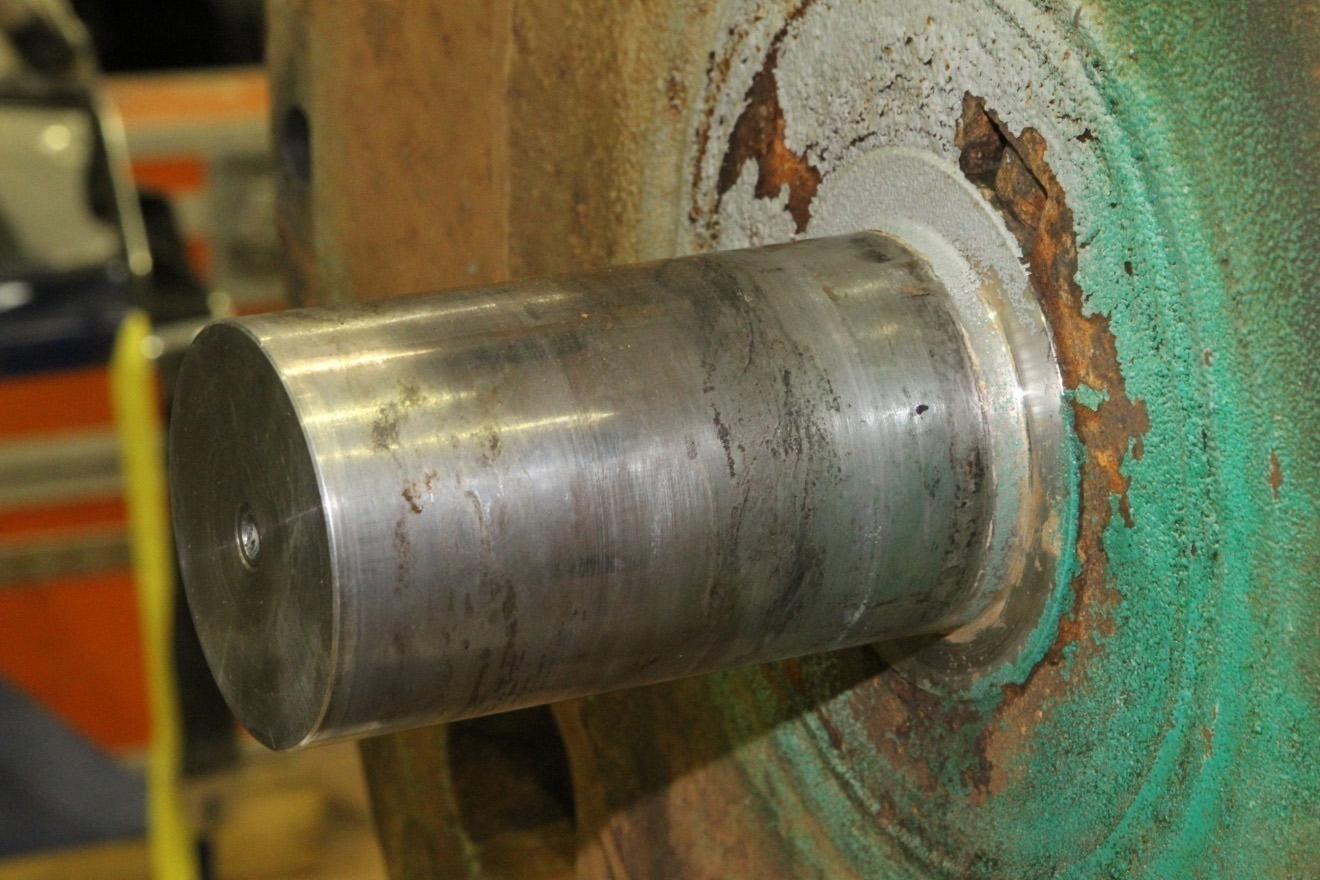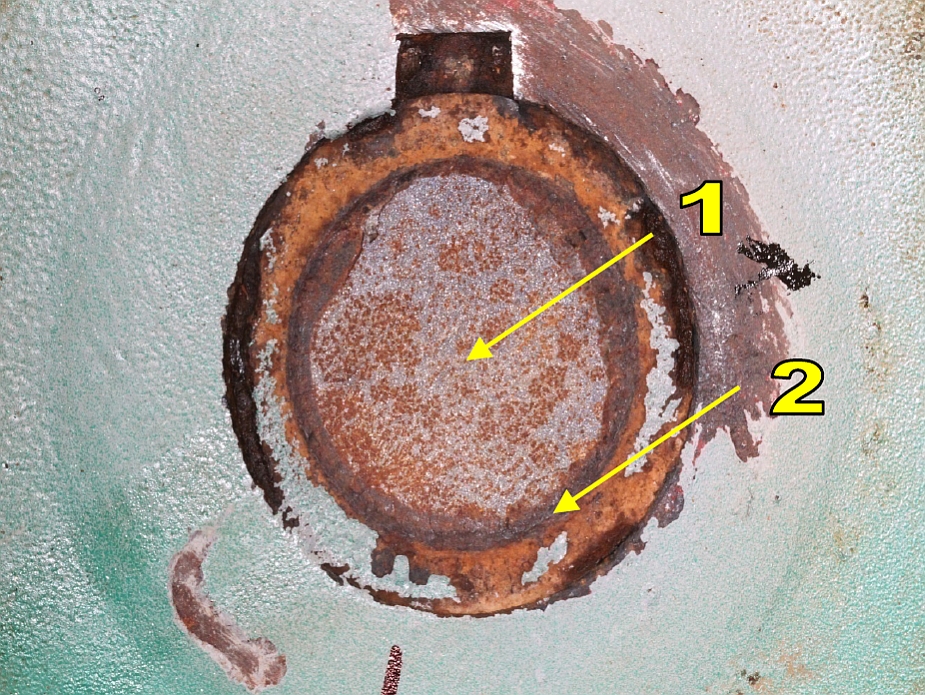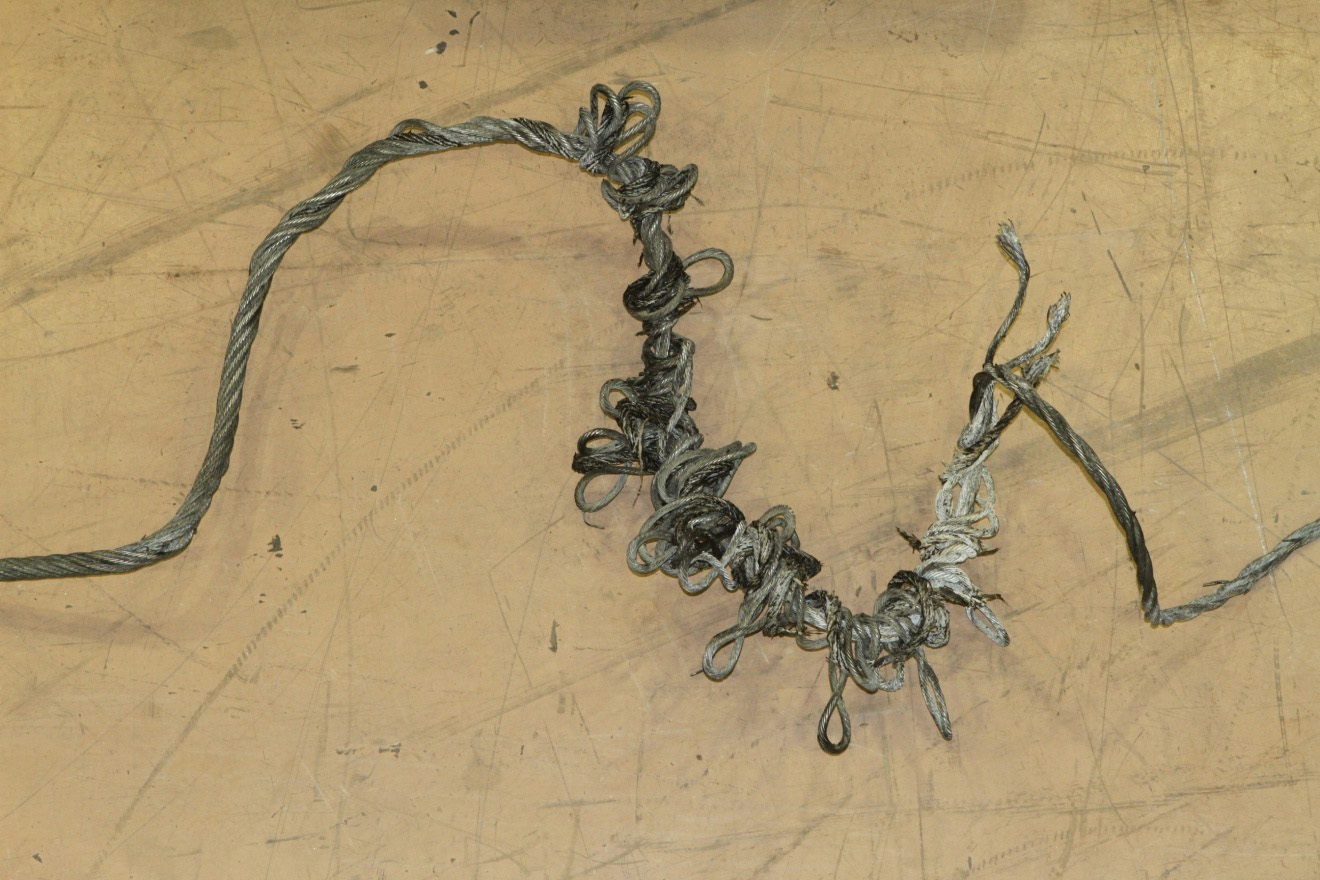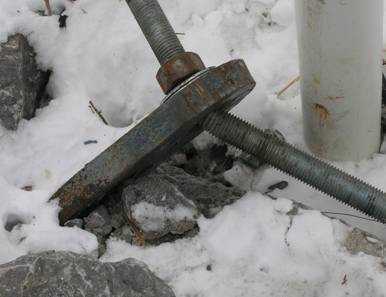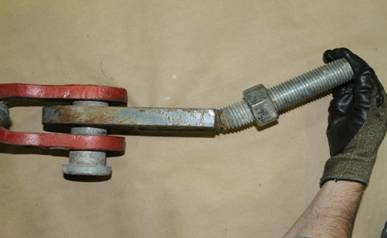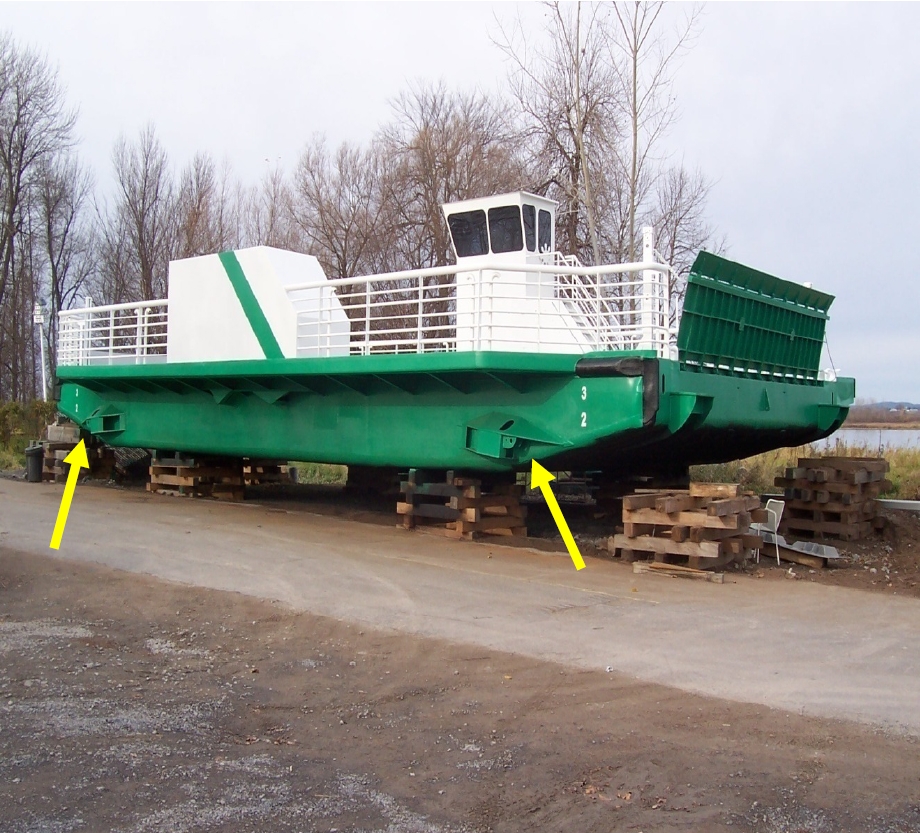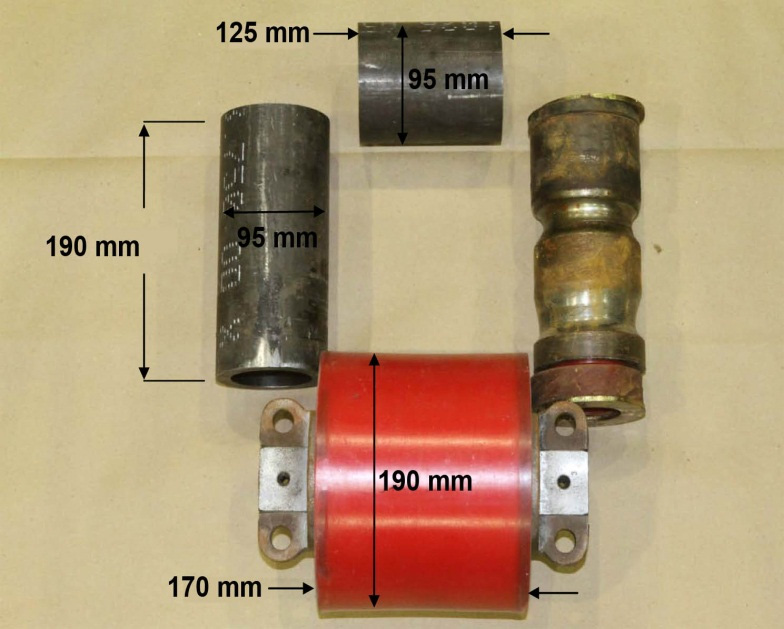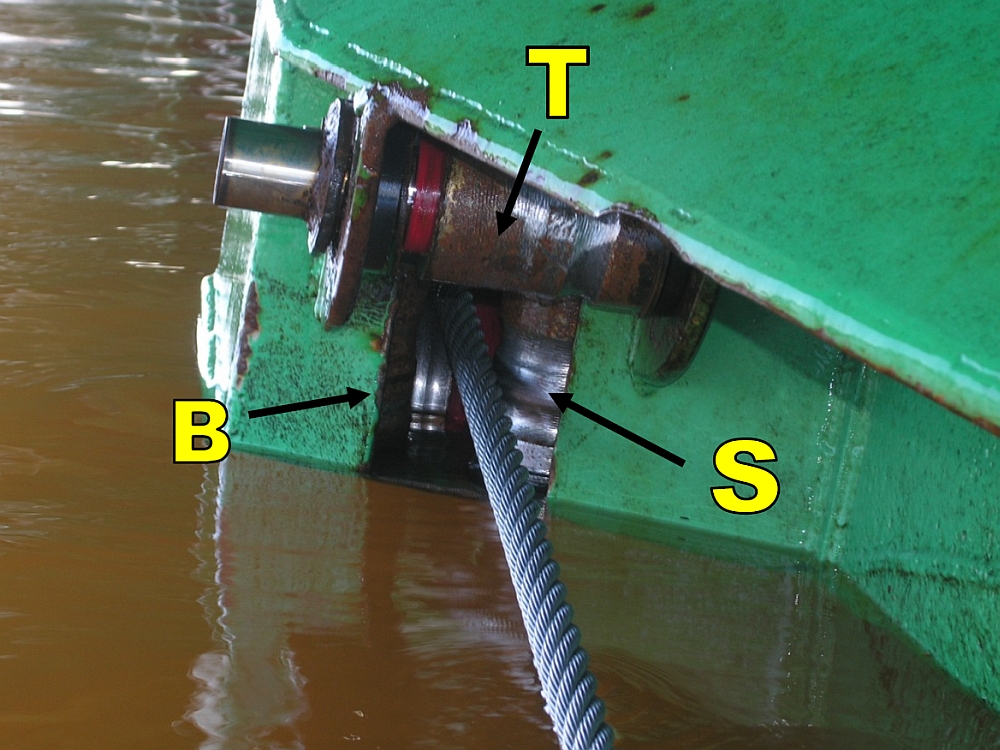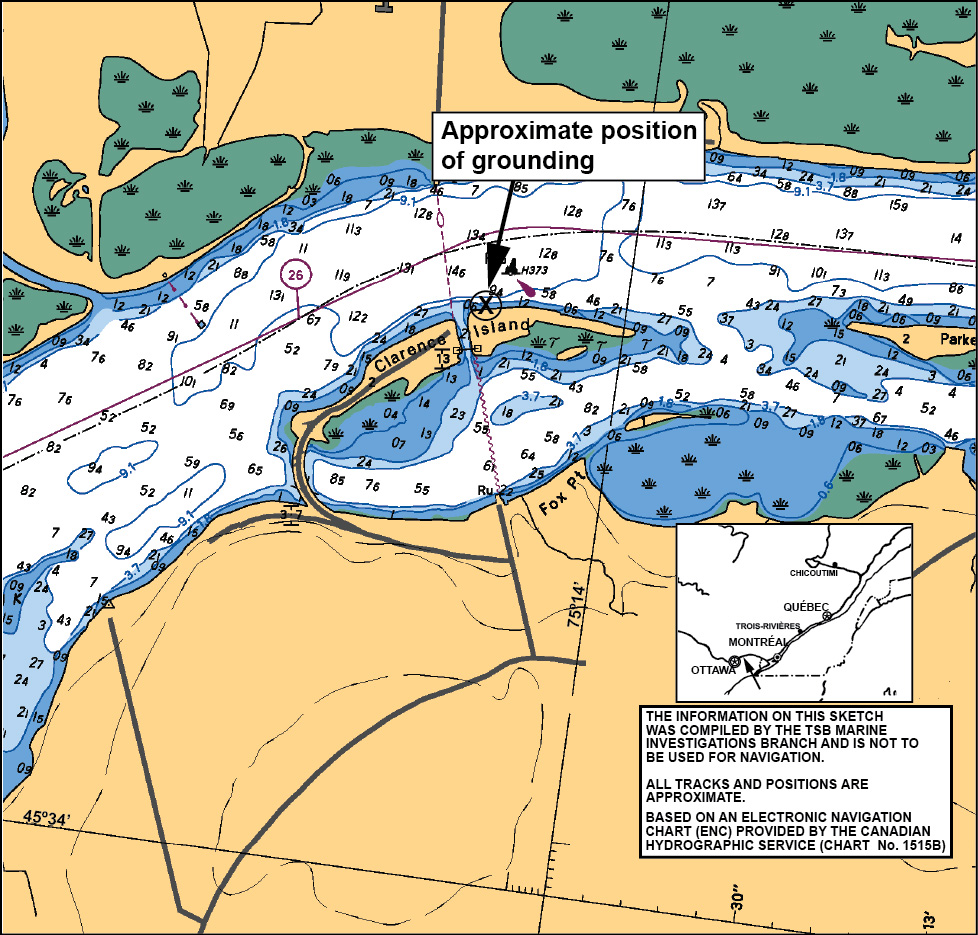Contact with Ice and Subsequent Mechanical Failure
Cable Ferry Ecolos
Ottawa River
Near Rockland, Ontario
The Transportation Safety Board of Canada (TSB) investigated this occurrence for the purpose of advancing transportation safety. It is not the function of the Board to assign fault or determine civil or criminal liability. This report is not created for use in the context of legal, disciplinary or other proceedings. See Ownership and use of content. Masculine pronouns and position titles may be used to signify all genders to comply with the Canadian Transportation Accident Investigation and Safety Board Act (S.C. 1989, c. 3).
Summary
On 09 December 2010, the electric cable ferry Ecolos was undertaking its last crossing of the year from Thurso, Quebec to Rockland, Ontario on the Ottawa River. At 2045, Eastern Standard Time, the ferry experienced cable, drive assembly and shore attachment failures as ice pans accumulated against the upstream side of the hull. The ferry remained tethered to the shore at Rockland by the damaged west cable. It then drifted downriver until coming alongside the shore ice. The 6 people on board were evacuated. There were neither injuries nor pollution.
Ce rapport est également disponible en français.
Factual information
Particulars of the vessel
| Name of vessel | Ecolos |
|---|---|
| Official number | 348014 |
| Port of registry | Kingston, ON |
| Flag | Canadian |
| Type | Cable Ferry |
| Gross tonnage | 43.50 |
| LengthFootnote 1 | 18.3 m |
| Draught | 1.39 m |
| Built | 1974 |
| Propulsion | electric drive, 2 x 130 kW |
| Crew | 1 (or 2 for more than 12 passengers) |
| Passengers | 5 (to a maximum of 48) |
| Registered owner | Traversier R-T Ferry Inc., Rockland, ON |
Description of the vessel
The Ecolos is a flat-bottomed barge of welded steel construction, approximately 11 m wide by 18 m long. The hull is subdivided into 7 watertight compartments. The vessel works as a double-ended roll-on–roll-off vehicle and passenger ferry and has hydraulic loading ramps fitted at each end. The vessel has no anchor, nor is it required to have one by regulation.
The vessel was built in 1974 as the Howe Islander and was operated by the Ministry of Transportation of Ontario as the Howe Island cable ferry until 2004 when it was purchased by the current owner. The Howe Islander operated in the St. Lawrence River from Howe Island, Ontario (east of Kingston), to the mainland. The crossing distance of 425 m was comparable to the Ecolos ferry crossing of 487 m. The ferry operated year-round through a track in the land-fast ice that was kept open by employing a bubbler system.Footnote 2 The ferry would temporarily cease operation when ice pans were flowing downriver in the early winter and during the spring break-up. The Howe Islander 2.9 cm (1 1⁄8 inch) cables were comparable to the Ecolos 2.54 cm (one inch) cables that were in use at the time of the occurrence.
The vessel underwent extensive modificationsFootnote 3 by the new owner and, in 2008, it went back into operation as an electric cable ferry. The Ecolos waspropelled by 2 electric drive motors powered by 3 battery banks charged approximately every 2 days using regular grid power supplied by Ontario Hydro. The vessel was inspected by TC in August 2008 and the drawings were approved on 25 November 2008. Prior to this occurrence, the Ecolos had operated successfully, including occasionally in ice covered waters, for almost 3 seasons without any reported problems.
The Ecolos operates between 0500 and 2200 (and between 0600 and midnight on the weekends) on the Ottawa River between Rockland, Ontario, on the south side and Thurso, Quebec, on the north side, on a seasonal schedule. It commences operations in the spring as soon as the ice is gone until the early winter, the day after the ice starts to form. The ferry crosses on demand when there is a person or a vehicle waiting.
The symmetrical cable drive assemblies are housed on either side of the ferry inside deck superstructures. Each drive assembly consists of an electric drive motor, a 1.9 m diameter electric drive wheel and a 0.86 m diameter idler wheel. Because the vessel travels back and forth only along its cables, the sides of the vessel, its equipment and associated drive systems are referred to as the east and west side, and the ends of the vessel are called the north and south end.
The Ecolos is connected to the shore on either side of the 487 m crossing by 2 cables.Footnote 4 The cables were each 518 m in length and rested on the bottom of the river, which was 14 m at its deepest.
On the east side of the vessel, the superstructure extends upwards to include an operator's bridge with a 360° view of the water and the vehicle deck. It is equipped with 2 independent propulsion controls (1 for each drive motor), a cellular phone, a deck lighting control panel, a gate selector valve, and a ramp hydraulic pressure control valve. There is also a computer system available for monitoring the electric drive motors.
Path of the cable
At the north end of the vessel and on either side of the ferry, the cable passes through a roller fairlead assembly below the waterline. It then passes up through the cantilevered side deck and loops over the drive and idler wheels before it runs back down through the side deck and finally through the roller fairleads below the waterline at the south end of the vessel. The idler wheels on either side of the vessel are canted outboard at an angle of approximately 2.5° off the vertical so that each cable passes by itself without contact. This arrangement creates a continuous travelling loop in both the east and west cables as the vessel advances (Figure 2a and Figure 2b).
Hydraulic brake assemblies are mounted on the cable drive wheels and keep the cable drive wheel from turning, thus holding the vessel in position on the cables. The brakes are automatically engaged whenever the ramp is lowered. The operator can reduce speed by bringing the throttle to the “0”
position.
History of the voyage
On 09 December 2010, at approximately 2045,Footnote 5 the Ecolos loaded 3 vehicles with a total of 5 passengers and departed from Thurso, Quebec. The operator was the only crew member on board. The number of vehicles was recorded on the ferry's log sheet. The operator noticed a significant increase in the number of ice pans flowing down the river, in comparison to the previous trips that day, so he timed his departure to coincide with a gap in the flow of ice pans, preferring not to pass through patches of ice.
The crossing normally takes 4 minutes. Pans of ice were accumulating against the west (upstream) side of the vessel as it crossed. When the ferry was approximately halfway across, there was a loud bang and the vessel stopped abruptly. The operator brought the controls for the electric drive motors to the stop position. He left the wheelhouse to investigate the bang, which came from the west drive assembly deckhouse. There was a film of ice on the surface of the river in addition to the flowing pans of ice; new ice and pans of ice covered approximately 90% of the river's surface when the vessel stopped. Ice pans continued to accumulate against the west side of the stopped vessel.
The west (upstream) idler wheel shaft had sheared off and the west cable was “bird–caged”Footnote 6 in way of the deck structure. The east drive assembly was intact. Around the same time, the east cable parted and unspooled from the drive system. Finally, the north shore attachment (at Thurso) on the west cable failed.
The operator returned to the bridge and used the vessel's cellular phone to call his wife for assistance. The ferry and the ice pans that were released from the side of the vessel started to drift downriver. The ferry, tethered to shore by the bird–caged west cable and the south–west shore attachment, came to a stop about 200 m downriver from the wharf and 25 to 50 m offshore against shore ice.
The 5 passengers on board had mustered themselves on the ferry deck after the loud bang. The ferry operator requested that everyone don the ferry's keyhole lifejackets. The passengers found the lifejackets stiff and uncomfortable. Consequently only 1 passenger donned a lifejacket but soon took it off.
The ferry operator called 3 off–duty ferry employees for assistance. A local resident saw the ferry close to his riverside home and walked across the ice to offer assistance. An evacuation plan was formed. One of the off–duty ferry employees the ferry operator had called lived nearby. He was waiting onshore to assist in the evacuation when the local resident returned from the ferry. The resident went back to the ferry, bringing his light aluminum skiff, a rope and his own vest–style personal flotation device (PFD).Footnote 7 The off–duty employee secured the skiff to shore and the resident secured it to the Ecolos using a nylon rope.
At approximately 2130, the ferry operator's wife and 3 Ontario Provincial Police (OPP) officersFootnote 8 arrived on scene. From shore, the police instructed the passengers to don their lifejackets. One police officer walked across the ice to the ferry. Once on board, he demonstrated how to don the keyhole lifejacket, but then removed it as it interfered with his evacuation assistance duties. He agreed with the passengers that the lifejacket was stiff and uncomfortable. He remained on board to assist with the evacuation of the passengers.
One by one, the 5 passengers donned the PFD from the resident's home and, carrying a keyhole lifejacket, boarded the skiff, which was then pulled across the ice. All passengers, the police and the resident were successfully brought ashore before 2200, a little more than 1 hour after the incident occurred. The ferry operator remained on board.
Once ashore, the passengers were invited by the local resident and the off–duty ferry employee to take shelter in their residences nearby. Two passengers accepted this offer. The remaining 3 passengers chose to hike approximately 100 m along the unlit shoreline and cross a privately owned floating bridge in order to reach the ferry landing. There, passengers were given the option of going to a restaurant, having a hot drink, or warming up in one of the police cruisers or in the ferry operator's van. No information about the passengers was collected.
The police departed early on 10 December. In the morning, an attempt was made to salvage the vessel using a shore–based heavy tow truck, which resulted in the vessel grounding on a nearby sand bar. In the early afternoon, a neighbouring tug boat was hired to pull the Ecolos into the Ottawa River from its grounded position. A tow truck was then able to winch the ferry into the ferry landing where the vehicles were recovered by their owners.
Certification of Crew
The ferry operator held an MED A3 certificate, as was required by regulation. The ferry operator had been operating the ferry since its conversion to electric propulsion and return to service in 2008. Since 2004, he oversaw all of the modifications to the vessel, hired and conducted crew familiarization and training.
Certification of Vessel
The Ecolos was registered in Canada and inspected annually by TC as a passenger vessel greater than 15 gross tonnage and carrying more than 12 passengers. It was removed from the water every 4 years for underwater hull inspection, maintenance and repairs, as per the Hull Inspection Regulations. On 09 April 2010, TC issued an annual inspection certificate to the Ecolos certifying the vessel to carry up to 48 passengers, including as many children, as there were lifejackets available to fit them. There were no restrictions indicated on the certificate other than to limit the vessel to sheltered waters.
Lifesaving equipment
The required lifesaving equipment plan displayed on board indicated the location of all equipment. There were 56 keyhole lifejackets stored on deck in a steel box. These lifejackets were type–approved by TC in 2006 and purchased by the ferry owner in 2008. They complied with the Canadian General Standards Board standard (CAN/CGSB–65GP–14M [1978]) for lifejackets in force at the time.
There was a 75–person inflatable life raft fitted with a hydrostatic release unit mounted on the east railing. A 5–person aluminum rescue boat, equipped with a 6–horsepower (HP) motor and oars, was secured to the east rail. The rescue boat could be lowered to the water by means of a winch. There were 2 lifebuoys fitted with buoyant heaving lines, one on the west side and one mounted just outside the bridge. The 6 distress flares and the first aid kit were located in the operator's cabin.
Environmental Factors
The Ottawa River flows at different speeds along its length, mostly due to its varying depths including waterfalls and white water rapids along its course. On 09 December, the current at Thurso was calculated at 1.2 knotsFootnote 9 and was within normal range.Footnote 10 The air temperature recorded by Environment Canada at the time of the occurrence was −15°C. The average temperature for the previous week was −5.7°C. Westerly winds averaging 15 km/h were reported throughout the day and overnight.
The average daily river water temperature fell from 2.8°C on 04 December to 0.5°C on 09 December, which is conducive to ice formation. On 09 December 2010, ice formation occurred rapidly. In the morning, landfast ice was noted along the shore but there were few flowing ice pans. At the time of the occurrence, large ice floes drifted down the river. Ice was forming in the cold air temperatures, creating ice crystals that formed a slush in the remaining open water. Together, the ice pans, the landfast ice and icy slush covered approximately 90% of the river surface.
Operator Inspections and Maintenance
The ferry operator conducted weekly visual inspections during a crossing by slowing down the motors and observing various sections of the cables as they passed through the drive assemblies. On an approximately bi–weekly basis, the ferry was listed by moving the battery banks to one side of the ferry to check the roller fairleads at each corner. The cables were replaced annually but never simultaneously; the cable change on each side was staggered.
The vessel's maintenance records were not transferred when the vessel was sold in 2004.
Cable Selection
Of the 2 types of cable available, 6x26 non–plastic filled valley independent wire rope core (non–PFV IWRC) or 6x26 plastic filled valley independent wire rope core (PFV IWRC), the operator chose the non–PFV cable. It was galvanized and offered the same base resistance to external abrasion as the plastic impregnated cable. The ferry cables were water lubricated as it is not considered to be environmentally sound to use grease or other lubricants in a submersed cable.
The 1 inch cable on the Ecolos had a breaking strength of 100 000 pounds, or 32 times the expected operating load of 3100 pounds. The ferry was designed to operate on one cable and drive system in the event of the failure of the other drive system or cable. Thus, the operating load on the remaining cable in the event of the failure of one system was calculated at 6200 pounds. This type of cable had been used successfully for almost 3 years on the Ecolos. When it operated as the Howe Islander, theferry used a similar cable but of 1½ inches in diameter with a breaking strength of approximately 105 000 pounds.
Post–Occurrence Examination of Failures
Following the occurrence, it was discovered that, in addition to the west idler wheel axle failure and the west cable “bird–cage,”
the east cable had failed approximately 90 m from Clarence Island and that the west (upstream) shore attachment at Thurso had also failed.
East Cable Failure
The tension in a cable is variable with the flow of the river and the speed of the ferry, as is the angle of exit/entry onto the rollers.
In April 2010, the east cable had been replaced at the start of the operating season. It was scheduled for replacement before the start of the 2011 season. Examination and testing by the TSBFootnote 11 revealed that the overall condition of the east cable in the service portion was poor, showing extensive wear with complete loss of galvanization and several broken strands. The residual strength of the cable was approximately 25% of its original strength. The east cable had deteriorated to the point that entire strand sections were missing near the point of failure. At the time of the occurrence, all 10 of the outer wires of each strand had been worn through or fractured. The east cable failed under relatively low stress with no strand deformation.
Idler Wheel Axle Failure
The idler wheel axle was a reused part from the original Howe Islander ferry.
The west idler wheel axle had failed at the outboard and inboard change of radius on both sides of the wheel. This was due to the overstress extension of pre–existing fatigue cracks. Examination of the failed idler wheel axle revealed other factors that may have contributed to its failure. The axle diameter was 10.6 cm inside the idler wheel and stepped down to 7.62 cm inside the bearings, located on either side of the wheel. The investigation determined that the 1⁄32 inch fillet radius between the large and small diameter cross–sections of the failed axle generated a local stress concentration. Surface conditions such as sharp edges or fillets, surface flaws and roughness reduced the fatigue limit by acting as stress risers.Footnote 12 The material of the failed idler wheel axle was low alloy steel, which had a lower ultimate tensile strength than the stainless steel axle in use on the drive wheel. Therefore the fatigue resistance of the failed west idler axle was approximately one–third that of the intact east idler axle.Footnote 13
Although the vessel was inspected annually by TC, there was no requirement to test any parts of the drive mechanism. A visual inspection of the drive system is normally conducted during the annual inspection as well as by the operator on a weekly basis. However, under visual inspection, the fatigue cracks would not be visible. Even disassembled, the fatigue cracks would not have been detected, except by some form of non–destructive testing (NDT), Footnote 14 as the cracks only existed at the change of radius of the axle. Since the fatigue cracks covered only 25% (inboard) and 10% (outboard) of the axle, the investigation determined that the main mode of failure of the west idler wheel axle was overstress.
- Overstress failure (90%)
- Fatigue cracking around the periphery at the change of cross section. The corrosion indicates that the cracks had been present for some time.
West Cable “Bird Cage”
In August 2010, the west cable had been replaced halfway through the operating season. When the idler wheel axle failed, the west cable was no longer supported by the idler wheel. Its tension increased as it was bent against the tight radius of the deck structure when the vessel was pushed downriver by the force of the build up of ice against the upstream side of the hull. Examination of the cable showed that it had not completely failed but was reduced from 6 outer strands and the core strand to only 3 outer strands. Examination of the failed strands showed primarily tensile failure. The strength of 3 sample sections of the intact cable was equal to or greater than the cable's nominal strength of 100 000 pounds.Footnote 15 The west cable had recoiled on itself as the fractured strands “bird–caged,”
which is consistent with failure under high tensile stress. Little wear or corrosion was observed on this cable.
Shore Attachments
The west cable's attachment to shore at Thurso had fractured and was found in the snow approximately 3 m from its original location, consistent with failure under tension. The recovered shore attachment had failed at the point of a change in cross–section where the threaded rod had been welded to a piece of plate. Matching the fracture surfaces showed that the shore attachment had been heavily deformed before failure with no indication of pre–existing cracks.
Field examination of the west cable's south shore attachment (at Clarence Island) showed that it had also experienced high tensile loads. The threaded shore attachment rod was bent and the attachment plate, fabricated from thick plate material, had been plastically deformed toward the river.
Neither of the east cable's shore attachment assemblies had been bent or deformed, indicating that the residual strength of the east cable was significantly less than that of the shore attachment.
Ecolos Propulsion System Design
The vessel modifications were designed by a naval architect. The vessel was inspected by TC in August 2008 and the drawings were approved on 25 November 2008. Prior to this occurrence, the Ecolos had operated successfully for almost 3 seasons without any reported problems.
The roller fairleads installed at the 4 corners of the vessel are used to guide the cable onto the drive and idler wheels. Each of the 4 roller fairlead assemblies was constructed using top and side rollers made from 9.5 cm diameter, 1.2 cm thick steel pipe with a plastic sleeve as a bushing. The bottom roller was mounted on bearings. The rollers installed on the vessel showed extensive wear damage, particularly to the upstream side rollers and the bottom rollers.
The upstream rollers were replaced approximately every month while the other rollers were replaced every couple of years, depending on the level of wear. Roller wear on a cable ferry is dependent on the roller's location; upstream rollers tend to wear more quickly due to the friction caused by the cable that is in near constant contact with the surface, and is dependent on the water level of the river; higher water levels cause faster currents, pushing the vessel further downriver and hence off its track, thus increasing the angle of the cable entry/exit onto the roller.
There is a suggested minimum recommended diameter size roller for each diameter of wire cable. The cable in use, 6 x 26 Warrington seal independent wire rope core (IWRC) 2.54 cm (one inch) wire cable, should be used with a 76.2 cm (30 inches) minimum diameter roller.Footnote 16 Fatigue breaks may occur whenever a cable bends, especially when the minimum diameter is smaller than that suggested. A smaller diameter roller does not adequately support the cable and increases contact pressure. On the Ecolos, the fairlead rollers were of a smaller size (10.16 cm/4 inches) than the suggested minimum (76.2 cm/30 inches) and thus rotated more slowly than the speed of the steel cable, even though they were adequately lubricated.
In cable ferry operations, cables experience increased stress due to the variable load that is applied. The cable on a ferry operating in a river is always working at an angle as it passes through the rollers to the shore attachments. When a force is exerted at an angle on a cable, the tension is increased. Wear and fatigue is also accelerated in a cable that has been worked at an angle. In a dynamic environment such as a river, the tension is variable with the river current. Thus, even during normal operations, the Ecolos cables were bent at an angle around the rollers. When an additional lateral force is applied to the ferry, such as by the ice in this occurrence, the tension on the cable is increased further.
As a result of travelling over the smaller rollers and working at an angle, after a full season of service, the external strands of the east cable exhibited wear. The use of undersized rollers is not uncommon, nor is the bending stress, to which the ferry cable is subjected. Information obtained by the TSB during the investigation indicated that many cable ferry operators, including the Ecolos operator, make provisions during the construction and the operation of the ferry to allow for accelerated cable wear. This practice is both common and acceptable within the cable ferry industry.
Passenger Safety
Lifejackets
The investigation determined that the keyhole lifejackets on the Ecolos were stiff and uncomfortable. On the night of the occurrence, the temperature was −15°C. When the Ecolos passengers were instructed to don the lifejackets, 4 of the 5 did not. The passenger who donned the lifejacket removed it after only a short time. Neither the ferry operator nor the police wore keyhole lifejackets. During the evacuation each passenger chose to don the vest–style PFD provided by a local resident and carried a keyhole lifejacket.
Accounting for Passengers
Passengers were not counted as they boarded the Ecolos, nor was there any requirement to do so.Footnote 17 The Ecolos ferry operator instead kept track of the number of vehicles that were transported on each crossing. Across Canada, cable ferry passenger counting practices vary widely. Most cable ferry operators, similar to the Ecolos, count only the number of vehicles and keep all data on board, transferring it to a shore–based data system periodically. The frequency of transfer varies from daily, weekly, monthly to seasonally. Other ferry operators count both the number of vehicles and the number of passengers on board. The investigation found only one cable ferry where the number of passengers are counted and recorded in a real–time, shore–based data system.
The Board believes that the approach to accounting for passengers should be tailored for each individual vessel in order to address the potential risks of a particular voyage and the most appropriate means of addressing them. In 2008, the Board therefore recommended that:
The Department of Transport, in conjunction with the Canadian Ferry Operators Association and the Canadian Coast Guard, develop, through a risk–based approach, a framework that ferry operators can use to develop effective passenger accounting for each vessel and route.Footnote 18
Transportation Safety Recommendation M08-01
In response to this recommendation, TC amended the Canada Shipping Act (CSA) Fire and Boat Drills Regulations to make the recording of certain passenger information mandatory, including the updating of that information, and its availability to crew in the event of an emergency. However, cable ferries are currently exempt from compliance with the Fire and Boat Drills Regulations.
Passenger Briefings
Since 2002, both the Lifesaving Equipment Regulations and the Small Vessel Regulations require that all operators of passenger vessels provide a safety briefing to passengers. Most operators of cable ferries achieve this passenger briefing by posting a sign at the waiting area located at either end of the crossing or, as was done in this occurrence, by posting a sign on board the cable ferry. This briefing may be provided in a variety of formats. For example, lifesaving information can be distributed using placards placed on each vehicle windshield during a brief crossing.
Passenger Rescue
The Ecolos ferry operator communicated updates and directions to the passengers throughout the incident. He directed the passengers to don the lifejackets. He demonstrated how to don the vessel's keyhole lifejackets, although he did not continue to wear the lifejacket. He created and executed the evacuation plan, together with the local resident. It was reported that some of the passengers were not adequately dressed to hike through snow and across the floating bridge, as was necessary in this occurrence. Other than the passengers' own vehicles, there was no shelter on the cable ferry. However, there were many options once the passengers were on shore. The 5 passengers were evacuated from the ferry in just over 1 hour.
The Ecolos Urgences et Formation Manual does not cover the procedures to follow in an emergency where a cable parts, although it details the steps to take in case of evacuation. Since the cable ferry has 2 cables, the ferry operator and TC agreed that if one cable parted, the ferry would be able to return to shore by spooling itself along using the other intact cable.
Although the OPP was not formally advised of the emergency, they were on scene within minutes of the incident. No other rescue authorities were called in to respond although the Ottawa Fire Department and the Service d'Incendie de Gatineau have a combined fleet of 10 water rescue units.Footnote 19
There are also 6 seasonal Coast Guard Rescue Auxiliary (CGRA) units operating on the Ottawa River. However, at the time of the occurrence, none were available to provide assistance. In the past 5 years, there have been 24 incidents on the Ottawa River to which the CGRA responded.
Distress Alerting and Communications
The Canada Shipping Act, 2001 states that all vessels shall respond to a distress. However, a vessel can only respond to a distress if the crew is alerted to the situation. At sea, very high frequency (VHF) radio is often used to alert both shore and nearby vessels of a distress situation so that they can offer assistance. VHF channel 16 (156.8 MHz) is the international marine calling and distress channel. Vessels are often fitted with marine VHF radios, many larger vessels by regulation, but the investigation determined that on the Ottawa River, boaters do not use VHF because no one is tasked with monitoring VHF channel 16. In other regions, Coast Guard Marine Communications and Traffic Services (MCTS) maintain a listening watch on channel 16. MCTS, also known as “Coast Guard Radio,”
listens for marine distress calls and passes them on to local Search and Rescue (SAR) authorities.
In 2000, the Board issued a safety concern that “channel 16 VHF radio communications in the Ottawa area still cannot be monitored by MCTS stations, and that local communications and SAR resources are not effectively organized or coordinated by the CCG SAR.”
Channel 16 on the Ottawa River remains unmonitored.
Since that time, a system has been developed whereby vessel operators may use a cellular telephone when in a service area to telephone a shore contact, dial 9–1–1 or access the MCTS system by dialing *16. Using posters and word of mouth, local marinas advocate using 9–1–1 to signal marine distress on the Ottawa River, although there are areas on the Ottawa River where there is no cellular coverage. Pamphlets are handed out at the Ottawa River locks advising boaters that the area is outside of VHF listening range. Boaters are advised to check the cellular coverage in the area that they intend to transit.
In this occurrence, there was no 9–1–1 call made, nor was MCTS alerted about the situation. The OPP was conducting a routine highway check and learned about the occurrence from the ferry operator's wife. The OPP advised the TSB and the Joint Rescue Co–ordination Centre at Trenton (JRCC). TC was not made aware of the grounding at the time of the incident, contrary to regulatory requirements.Footnote 20
There are at least 25 registered commercial passenger vessels operating on the Ottawa River and an estimated 120 small commercial vessels. Additionally, there are thousands of pleasure craft operators on vessels of varying sizes. Since 2002, there have been 13 reportable marine occurrences on the Ottawa River between Quyon, Quebec, and Carillon, Quebec.
Cable Ferries in Canada
Information obtained by the TSB indicates that there are at least 65 operating cable ferries in Canada. TC reported that there are 49 registered cable ferries, of which 38 are inspected. Every province and territory except Nunavut, PEI, and Newfoundland and Labrador has cable ferry operations. Canadian cable ferries carry between 1 and 30 cars. While some cable ferries are seasonally operated, there are many cable ferries that operate year–round, even in ice covered waters.
Some cable ferries make crossings during limited hours only, while others operate 24 hours per day. Many cable ferry services have been in existence for over a century. There have been 30 occurrences involving cable ferries reported to the TSB since 1975, but no associated fatalities. There have been 13 occurrences involving cable and drive assembly failures, of which 10 resulted in the ferry being adrift, including this occurrence. Many Canadian cable ferries are owned and operated or contracted by provincial transportation agencies. Others, such as Ecolos, are whollyprivate enterprises.
Analysis
Decision to Sail
During its service as the Howe Islander ferry, the Ecolos was operated year round even during the winter months. It generally operated in a track through land fast ice that was kept open with a bubbler system. During spring break–up and in the early winter, the ferry was occasionally exposed to flowing ice. It was left to the discretion of the ferry captain to determine if the ferry was to temporarily cease operations for this reason. There were no specific guidelines or policies in place.
In the absence of specific policies or procedures, a ferry operator must evaluate and make decisions about the safest course of action to take when confronted with a situation outside the normal operating routine. In this occurrence, the operator had advertised that service would continue until 09 December 2010, the day after the ice had started to form. When he observed an increase in ice on the river that day, he nonetheless decided to make the final crossings of the season. A combination of factors led the ferry operator to decide to cross despite the risk posed by the unexpectedly high concentration of ice on the river. The service date had been advertised in advance, the customers were waiting to cross, and the vessel was on the side of the river opposite its winter storage location.
Restrictions were not placed on operating in ice either by TC or by its owner. Consequently, it was left to the discretion of the operator whether or not to cross. Without specific guidelines about acceptable environmental conditions for cable ferry operation, the ferry operator chose to cross the river despite the risk posed by the increased concentration of ice.
Research in human behaviour has demonstrated that when people must solve a problem in a situation with no overarching guidelines or rules, they tend to frame the problem as a choice between gain and loss. Studies find that people are biased towards choosing a solution with a potential high risk, rather than choosing a solution that has a certain negative outcome. The ferry operator's decision making process was influenced by this kind of negative framing bias.Footnote 21 In this case, the ferry operator chose the potential risk of crossing the river in ice over the certain negative outcomes involved in not crossing.
Mechanical Failures
Cable ferries are unique vessels. Since they move only along cables attached to shore, they have limited manoeuvrability. If flowing ice accumulates on the upstream side of the cable ferry, it is exposed to higher than normal lateral loads.
At the time of the occurrence, ice pans accumulated against the side of the Ecolos during its crossing, exerting a greater lateral force on the ferry than that normally encountered. In effect, the cable ferry's displacement was increased by the ice pushing against the hull, causing it to be pushed downriver (Figure 3). Wire cables are designed to resist load in tension only, that is, a constant load in a straight line, unless adequately supported by a roller of an appropriate size. As the ferry was pushed laterally by the force of the ice on the upstream side of the hull, the cables were forced to pass through the drive system at a decreasing angle over the undersized roller (from 180°, or a straight line), increasing the stress on the cable and thus on the drive system.
Cable manufacturers recommend that a wire cable be replaced when the outer strands are worn to a 1⁄3 of their original diameter. After one season of service, all of the external strands of the east cable were either worn through or fractured due to friction with the undersized fairlead rollers. The east cable had a residual strength of 25 000 pounds and the normal operating load of the cable was calculated at 3100 pounds. Thus, even badly worn, the east cable's residual strength exceeded the expected design operating conditions by a factor of 8.
The ferry operator was aware of the deteriorated condition of the east cable, and it was scheduled for replacement at the end of the operating season. In ferry operations utilizing only one cable, inspection may have prompted replacement of the east cable due to its poor condition. However, in the present dual cable set–up, the Ecolos could operate using only one cable and drive assembly to return to shore. In fact, the design operating load of the ferry using one cable and drive system was calculated at 6200 pounds, still well below the residual strength in the east cable.
The west idler wheel had pre–existing fatigue cracks which penetrated to a maximum of 25% of the surface area. The mode of failure for the idler wheel axle was primarily overstress caused by the increased tension in the cables that was caused by the force of the current pushing the ice against the ferry. The design of the axle may have contributed to the existing fatigue crack. Also, the change of section and the small fillet radius acted as local stress risers. Once the west idler wheel axle failed, the west cable bent against the deck structure and birdcaged.
Maintenance and failure information on safety–critical components are most useful if always available with the ship to which they relate, regardless of the identity of the ship's manager/owner. The lack of a continuous lifetime maintenance record on a vessel may preclude proper maintenance and trend analysis, thus increasing the risk of machinery failure. Because maintenance records were not transferred when the vessel was sold, the investigation was unable to determine the age or origin or inspection / maintenance history of the idler wheel axles.
The north shore attachment failed under high tension. It had no pre–existing faults and was found in the snow approximately 3 m from its attachment point. This indicates that the cable ferry drive system experienced higher than normal forces due to the flowing ice.
The lateral force of the ice flow on the ferry generated stress that exceeded the expected normal operating conditions and the investigation determined that the west idler wheel axle and east cable failures occurred nearly simultaneously. Once the initial failure had occurred, the ice pans continued to build up against the side of the ferry while the ferry was stationary in the river. Regardless of which component failed first, the stress was beyond the residual load bearing capacities of the components and caused each to fail. The worn east cable parted, the defective west idler wheel axle sheared and caused the west cable to bird–cage, and finally, the northern shore attachment failed. The ferry drifted, tethered to shore by only the south west shore attachment, necessitating an evacuation of the passengers on board.
Cable Redundancy
Since the Ecolos had 2 cables, the ferry operator and TC agreed during the annual inspection that if one cable parted, the second cable would serve as a back–up. In this occurrence, the ferry operator was aware of the wear to the east cable, and it was due to be replaced before the start of the new season. Because of the staggered cable replacement schedule, one of the 2 cables was always in relatively good condition, ensuring redundancy.
In this occurrence, the east cable failed and the parted cable was completely unspooled from the drive assembly. However, the west cable also partially failed, in combination with the idler wheel axle failure although it did not part. Since the cable “bird caged,” it was caught in the west drive assembly and held the vessel tethered to shore.
In 1996, the New Brunswick cable ferry F39's single cable parted and it drifted down the Saint John River for over 5 miles before being recovered.Footnote 22 In response to this occurrence, New Brunswick and British Columbia fitted their provincial cable ferries with anchors. This provides a measure of control in case of cable failure. In a separate occurrence, ferry F39 parted its cable but, just as the Ecolos, the failed cable jammed in the drive gear and the tethered ferry was swept onto shore by the current.Footnote 23
In this occurrence, both cables failed, however one cable failed only partially. In the event of a total failure of both cables, the Ecolos had no emergency back–up. There was no means to hold the vessel on station against the river current and ice or to safely bring the vessel ashore. In the event of both cables parting and without means for preventing the cable ferry from going fully adrift, the cable ferry, passengers and crew may be placed at risk.
Passenger Safety
Keyhole Lifejackets
Lifesaving equipment must be easy to use and available to ensure that it is used during an emergency. In this occurrence, the on–board keyhole lifejackets were easy to use and available, yet none of the passengers wore them during the evacuation even though they had been instructed to do so by the ferry operator and later, by the police officers. The passengers reported that the lifejackets were inflexible and uncomfortable. It is a common complaint that keyhole lifejackets are uncomfortable due to the necessary tightness around the neck, as per lifejacket performance standards dictate that the lifejacket must keep a person's head out of the water.
In this situation, none of the passengers, rescuers, police, nor the ferry operator wore the keyhole lifejackets. The investigation determined that they were not worn because the lifejackets were uncomfortable to don, there was an alternative available (the PFD borrowed from the cottage owner) and the perception of risk was low.
Accounting for Passengers
During an emergency, it is essential that all passengers be accounted for. A full accounting of passengers and crew at an early stage in an emergency provides responders with critical information as to whether a detailed search is necessary and to optimizes the use of resources. In the case of an evacuation, as in this occurrence, awareness of the number of passengers allows operators to ensure that everyone has been evacuated safely.
The investigation determined that most cable ferry operators keep track of the number of vehicles crossing for ticketing purposes. However, only a few count passengers. Furthermore, information about the number of vehicles and passengers is normally kept on board and not transmitted ashore before departure.
There was no procedure established on the Ecolos to count the number of passengers on board, nor is there a requirement to do so on cable ferries. While the operator took note of the number of vehicles on board, he was not aware of the number of passengers. In this instance there were only 5 passengers. However, the vessel is capable of carrying up to 48 passengers. Lack of awareness of the number of passengers on board could have resulted in confusion and potentially losing track of persons during the emergency.
When vessel operators do not collect information about how many passengers are on board and do not transmit this information ashore, passengers are at risk of not being accounted for in the event of an emergency.
Distress Alerting and Communications
It is important that vessels experiencing difficulty notify the appropriate authority as soon as possible, so as to ensure timely assistance should it prove necessary. Although some vessels are equipped with VHF radios, there is no monitored, coordinated distress signalling system on the Ottawa River. Use of VHF radio allows boaters to alert other boaters of their situation, including the community of boaters on the water.
In this occurrence, the ferry operator opted to call his wife and 3 off–duty employees, rather than notify the appropriate emergency authorities through 9–1–1 or *16. However, in instances where the appropriate authorities are not notified, SAR response may be delayed, thereby placing vessels, passengers and crew at risk.
Findings
Findings as to causes and contributing factors
- Without specific guidelines about acceptable environmental conditions for cable ferry operation, the ferry operator chose to cross the river despite the risk posed by the increased concentration of ice.
- The lateral force of the ice flow on the ferry generated stresses beyond the residual load bearing capacities of individual drive components and caused each to fail.
- The design of the idler wheel axle may have contributed to its existing fatigue cracks, also, the change of radius and the sharp fillet angle acted as local stress risers.
- The undersized design of the roller fairleads resulted in accelerated wear to the cables.
Findings as to Risk
- In the event of both cables parting and without means for preventing the cable ferry from going fully adrift, the cable ferry, passengers and crew may be placed at risk.
- When vessel operators do not collect information about how many passengers are on board and do not transmit this information ashore, passengers are at risk of not being accounted for in the event of an emergency.
- Failure to declare distress to the appropriate authorities delays the search and rescue response, thereby placing vessels, passengers and crew at risk.
- The lack of a continuous lifetime maintenance record on a vessel may preclude proper maintenance and trend analysis, thus increasing the risk of machinery failure.
Other Finding
- No one on board donned the keyhole lifejackets because they were uncomfortable and the perception of risk was low.
Safety Action
Safety Action Taken
The owner of the Ecolos has modified the design of the drive system such that the idler wheel axles are of a continuous diameter, that is, 10.6 cm (4 inches), from bearing to bearing. Floating bearings have been installed on either side of the axles. The bottom rollers on the Ecolos are now constructed of 100% polyurethane. There is a “weak link” installed at the cable shore attachments. Swaged 6 x 26 independent wire rope core (IWRC) cables have also been installed.
This report concludes the Transportation Safety Board's investigation into this occurrence. Consequently, the Board authorized the release of this report on .
